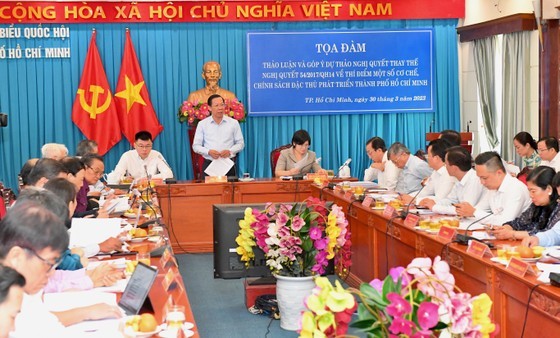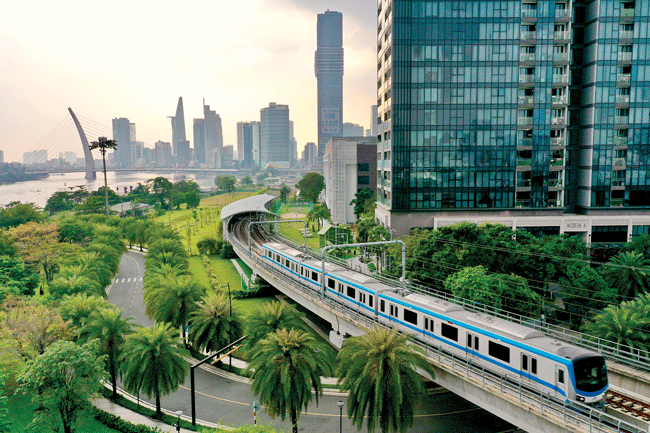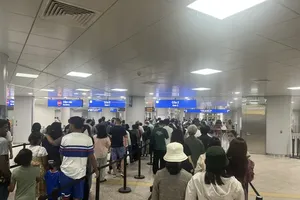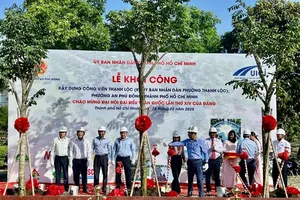 |
Chairman of the People's Committee of Ho Chi Minh City Phan Van Mai at the seminar ( Photo: SGGP) |
He made the statement at this morning’s seminar, organized by the HCMC delegation of National Assembly (NA) Deputies. to discuss and comment on a draft resolution to replace Resolution 54/2017/QH14 on piloting a number of specific development mechanisms and policies for the southern metropolis’s growth.
Chairman of the People's Committee of Ho Chi Minh City Phan Van Mai, Deputy Head of the NA Delegation of HCMC Van Thi Bach Tuyet, Deputy Director of Ho Chi Minh City Institute for Development Studies Truong Minh Huy Vu chaired the seminar.
Speaking at the opening of the seminar, Chairman Phan Van Mai revealed the contents related to the preparation of a draft resolution to replace the Resolution 54. Accordingly, the Resolution 54 was summarized by the National Assembly at the end of 2022 which allowed the implementation to be extended until December 31, 2023.
During that time, the National Assembly asked the Government to direct the Ministry of Planning and Investment to coordinate with the southern largest city and other ministries and agencies to develop a new resolution to replace the Resolution 54. Ho Chi Minh City has urgently coordinated with the Ministry of Planning and Investment and other ministries and agencies to give the Government advice on resolutions to replace the Resolution 54.
According to Mr. Phan Van Mai, the Resolution 54 focuses a lot on exploiting revenue sources for Ho Chi Minh City. He announced that HCMC does not attach great importance to revenue sources but proposes to pilot outstanding breakthrough mechanisms to mobilize financial resources for the city’s development.
Breakthrough mechanisms have not been regulated by the law or that the law has provided for, but overlapped and have not yet solved the practical problems of the city's development to free up and mobilize financial resources for the development of Ho Chi Minh City.
At the same time, the city expected that the breakthrough mechanisms can mobilize resources for the city to materialize the goals of the Politburo’s Resolution 24 on socio-economic development and assurance of defense and security in the Southeast region and the Politburo's Resolution 31.
Ho Chi Minh City is not only a locality of Vietnam but also a locality with the ability to integrate and compete internationally with other cities in the region and the world. Hence, the city proposed mechanisms and policies that meet the criteria; amongst them, some policies were proposed by central agencies, ministries, agencies and experts for the city’s growth.
Chairman of the HCMC People's Committee affirmed that in the process of developing a new draft resolution, Ho Chi Minh City determined to build a resolution with outstanding breakthrough mechanisms and policies not only for Ho Chi Minh City but also for the country as the city’s development also contributes to the country’s.
According to Chairman of the People's Committee of Ho Chi Minh City, the draft resolution to replace Resolution 54 is expected to have 4 groups of contents with about 40 outstanding mechanisms and policies. Amongst them, a group of mechanisms and policies has been already added in the Resolution 54 while another group of specific mechanisms and policies already exists with other localities and another group of contents to be included in the amendment of the law. A group of new mechanisms and policies has been proposed by Ho Chi Minh City and suggested by central agencies.
After finishing his speech, the Chairman of Ho Chi Minh City People's Committee expected delegates to voice their comments on the draft resolution as well as the city's implementation of the resolution approved by the National Assembly. After the seminar, Ho Chi Minh City listened to opinions and will coordinate with the Ministry of Planning and Investment and central agencies to complete the preparation to submit to the National Assembly Standing Committee.
Based on the suggestion of Prof. Tran Hoang Ngan, former Director of the Ho Chi Minh City Institute for Development Studies, Secretary of the Ho Chi Minh City Party Committee Nguyen Van Nen said that in the past time, the Politburo and the Central have issued many resolutions to develop Ho Chi Minh City. The resolutions always emphasize Ho Chi Minh City's leading role in promoting national growth and international competition. In fact, in the process of implementing resolutions, Ho Chi Minh City has always shown its leading role in budget contribution and GDP growth.
According to deputy Tran Hoang Ngan, it is good news that the Politburo has appreciated the efforts of Ho Chi Minh City; thereby, the Politburo continued to issue Resolution 31 on the city’s development. The Resolution 31 continues to highlight the important role of Ho Chi Minh City as the economic locomotive of the country while it is leading the growth of the Southeast region, as a city developed on par with other cities in the world, and as an attractive destination.
Affirming the need for a new resolution to replace the Resolution 54, Mr. Nguyen Si Dung, former Deputy Chairman of the National Assembly Office, said that Ho Chi Minh City needs to focus on good preparation for the implementation of the new resolution after the National Assembly approves it.
Citing many development models of countries around the world, Mr. Dung said that in order for Ho Chi Minh City to become a financial center, the testing mechanism model should experiment with because developed countries such as the UK and the US have applied this model and have achieved much success.
Meanwhile, former deputy director of the Central Institute for Economic Management (CIEM) Vo Tri Thanh said that the draft resolution to replace the Resolution 54 has learned from the Resolution 54 as well as from some specific mechanisms in provinces.
Mr. Vo Tri Thanh said that the draft resolution should take heed of Ho Chi Minh City’s role in the country’s present development as well as in the future. At the same time, it must be recognized that the current growth rate of labor productivity in the city is on a downward trend. According to him, the reason is that many current mechanisms and policies are not enough to solve the practical problems which the southern largest city is facing. Therefore, the new resolution needs to address these issues.


















)





